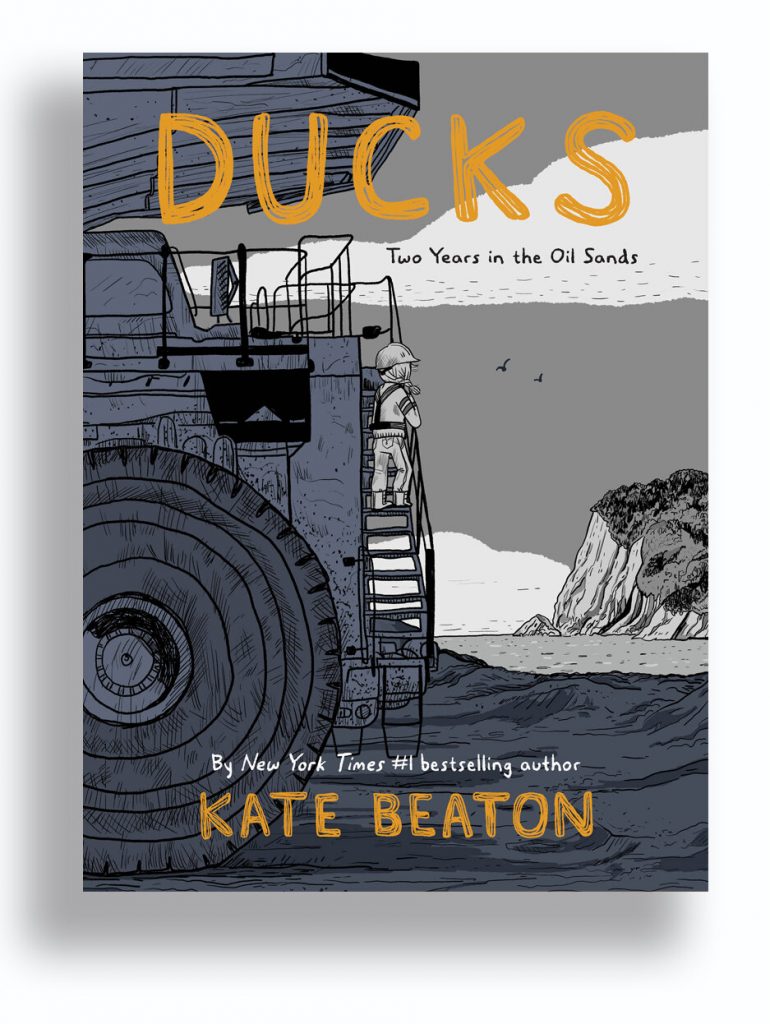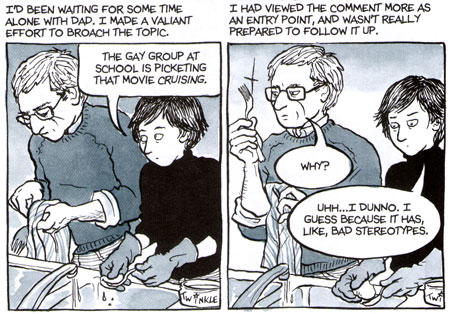
Newly graduated from college with artistic talent, a liberal arts degree, and a mountain of college loans, 21-year-old Kate Beaton departs her economically depressed home in the Canadian maritimes in search of work and income to pay down her debts. Like many other Canadians, she emigrates to the land of big salaries, the oil sands of Alberta.
Ducks is a coming of age story endured by many college graduates who combine wanderlust, a can-do attitude, and the immortality of being young. Not unsurprisingly she faces isolation, loneliness, and the exhaustion of trying to adapt while working as hard as she can in a new land far from home.
But Kate is also immersed in a sea of roughnecked men in a frozen, dark wasteland bearing little semblance to a balanced society. The level of sexual aggressiveness and mistreatment directed at the few female employees is appallingly high and carefully rendered in cartoon characterizations, generally six panels per page for more than 400 pages. While the book’s title might refer to a band of migratory ducks poisoned in a waste-tailings pond, it probably also refers to the author’s position as a “sitting duck” hunted by predatory miners far from their own families, hope, or the restrictions of normal civilization.
Separating men from women, implies the author, in mining camps, college dormitories, the army, or by religious restriction is likely to lead to sexual degradation of women, LGBTQ+, and anyone with perceived or conceived weakness.
 This is the final installment of the biography of Congressman John Lewis’s youthful campaign for civil rights for America’s black population.
This is the final installment of the biography of Congressman John Lewis’s youthful campaign for civil rights for America’s black population. 




 A graphic, graphic-novel of the author’s descent, ascent, descent, and ascent through bipolar disorder. Her story is told with exceptional clarity, honesty, more than a little humor, and wisdom. It speaks to anyone that has ever suffered from a high, a low, or something worse, which I believe probably includes everyone. Her images and text are partnered perfectly and together prove to be remarkably informative. Her story opens with a discovery chapter, followed by denial, a highly educational center wherein author and psychiatrist spend considerable amount of time engaging in therapy and searching for the right cocktail of medications, and a satisfying conclusion.
A graphic, graphic-novel of the author’s descent, ascent, descent, and ascent through bipolar disorder. Her story is told with exceptional clarity, honesty, more than a little humor, and wisdom. It speaks to anyone that has ever suffered from a high, a low, or something worse, which I believe probably includes everyone. Her images and text are partnered perfectly and together prove to be remarkably informative. Her story opens with a discovery chapter, followed by denial, a highly educational center wherein author and psychiatrist spend considerable amount of time engaging in therapy and searching for the right cocktail of medications, and a satisfying conclusion.
 A coming of age memoir of a girl discovering her lesbianism at the same moment she is learning that her obsessive-compulisive, tyrannical father was a closeted homosexual. They story line sounds like a novel in part because Bechdel sees her childhood through the lens of fictional analysis. That left me disconcerted to be reading a graphic novel with references to Proust, Joyce, the Odyssey, Greek mythology, Henry James, Collette, and so on. To the extent I could follow the literary references I was moved by the author’s transparent, often painful, honesty about her life. The book triumphs as a graphic novel precisely because it combines the genres of high literature with a comic book.
A coming of age memoir of a girl discovering her lesbianism at the same moment she is learning that her obsessive-compulisive, tyrannical father was a closeted homosexual. They story line sounds like a novel in part because Bechdel sees her childhood through the lens of fictional analysis. That left me disconcerted to be reading a graphic novel with references to Proust, Joyce, the Odyssey, Greek mythology, Henry James, Collette, and so on. To the extent I could follow the literary references I was moved by the author’s transparent, often painful, honesty about her life. The book triumphs as a graphic novel precisely because it combines the genres of high literature with a comic book.